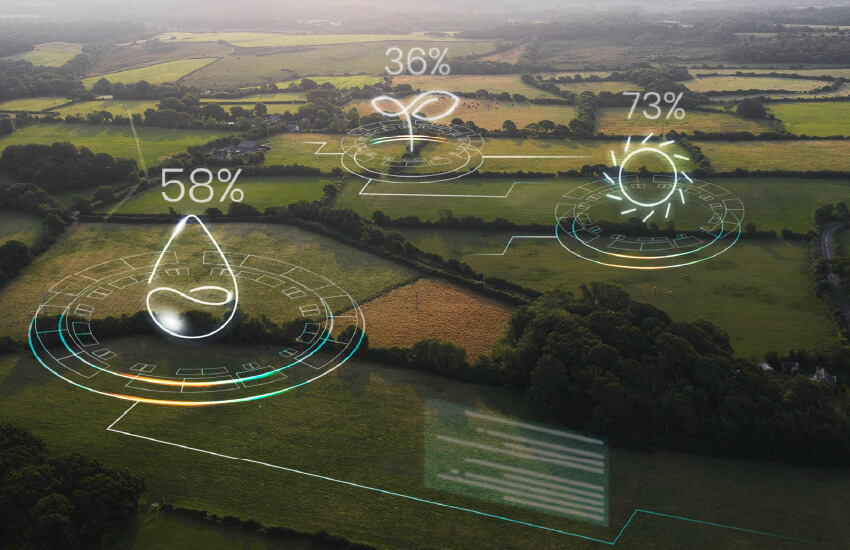How Cellular Networks Became the Backbone of the Intelligent Edge in the Internet of Things
by Webbing Team | April 23, 2025
As AI becomes a driving force behind innovation in the Internet of Things (IoT), cellular connectivity is proving to be just as essential. While IoT has long relied on cellular networks to transmit data to cloud-based AI systems, now the dynamic has shifted. Today, AI-powered IoT applications move closer to the edge, where decisions need to happen instantly and autonomously. From agricultural drones that decide where to spray, to smart factories running predictive maintenance in real time, AI is increasingly embedded within the IoT ecosystem. And it’s cellular networks that make this possible, delivering the speed, coverage, and responsiveness needed for edge computing and large-scale, intelligent deployments.
Before 2010, 2G and 3G technology supported basic IoT use cases such as GPS tracking and utility metering, with little to no AI involved due to limited bandwidth, high costs, and low device intelligence. The arrival of 4G with its faster speeds and lower latency made it possible for IoT devices to send richer data for analysis, enabling cloud-based AI applications. IoT devices like connected vehicles and smart cameras could now feed data into centralized AI systems for tasks such as predictive maintenance and route optimization. Cellular played a behind-the-scenes role in AI by getting data where it needed to go.
Between 2016 and 2020, cellular connectivity evolved into a key enabler of AI in IoT. With the introduction of LTE-M and NB-IoT tailored for low-power, wide-area IoT devices, cellular allowed continuous data transmission without relying on Wi-Fi. At the same time, private 4G networks emerged in industrial settings, and AI models became more widely applied in agriculture, logistics, and manufacturing. Cellular networks helped make this happen by letting devices send data in real time, receive remote updates and use AI on a large scale.
With 5G, cellular has become a core driver of real-time, edge-based AI. Ultra-low latency and high-speed data transfer now support autonomous systems that process and act on data instantly. Cellular is no longer just a transport layer, it’s the infrastructure that allows AI and IoT to operate together in real time, autonomously, and across large systems.
This shift is reflected in the evolution of cellular modules used in IoT devices. Early modules focused solely on cellular communication. Smart modules later incorporated CPUs and GPUs, supporting basic onboard processing. Now, AI-enabled cellular IoT modules integrate dedicated chipsets for AI acceleration, such as neural, tensor, or parallel processing units (NPUs, TPUs, or PPUs). As demand for edge AI grows, the market share of these smart and AI-integrated modules is expected to rise significantly, from just 2% each in 2023 to 10% and 9% respectively by 2027.

Let’s see how cellular connectivity drives AI in various verticals:
Transportation & Logistics
Cellular networks power real-time tracking, sensor data transmission, and autonomous decision-making in logistics. With cellular-connected IoT devices, AI analyzes data from fleets of trucks and containers in real time, tracking location, driver behavior, fuel usage, and predicting delays. AI also optimizes routes, predicts maintenance needs, and boosts fuel efficiency. Airports are implementing private 5G networks for autonomous vehicles managing baggage handling and AI-enabled systems optimizing gate traffic, or AI-powered security robots that patrol cargo areas and transmit live video feeds for threat detection and response.
Manufacturing
5G and private LTE networks bring real-time AI to factory floors, powering autonomous operations, real-time quality inspections and predictive maintenance. AI analyzes data from sensors on machinery to predict failures, optimize performance, and improve safety protocols. Besides, industrial robots, automated guided vehicles (AGVs), and machine vision systems used in smart factories or warehouses leverage AI to detect obstacles, follow pre-defined paths, and interact safely with humans — all in real time and while connected to a central system via cellular.

Agriculture
Cellular connectivity unlocks AI for remote farming operations, enabling precision agriculture even in rural areas. AI-powered IoT sensors track soil moisture, weather conditions, and livestock health. Public or private networks can support an automated IoT/AI system that weighs livestock to monitor growth rates and provides guidance about feeding, grazing and breeding, or AI-powered camera traps to monitor pest populations and reduce pesticide use. Drones, connected via cellular networks like 4G or 5G, analyze visual and environmental data on-board to avoid obstacles and optimize navigation, scan crops and make decisions like where to spray pesticides or when to irrigate.
Healthcare
Cellular connectivity allows wearable devices to transmit real-time health data to AI models, supporting remote patient monitoring, diagnostics, emergency response and wearable medical devices. Wearables send health metrics like heart rate, blood pressure, and glucose levels to AI systems for chronic disease monitoring and early diagnosis. AI also powers real-time remote surgery and diagnostics using live data streaming to healthcare professionals. Moreover, healthcare organizations implement smart surveillance cameras that can identify faces, detect unusual activity, and respond in real time, without needing to send video to a cloud server first. Hanyang University Hospital in South Korea has integrated a private 5G network solution to support AI-driven CCTV systems in emergency rooms and waiting areas and enable a real-time infusion monitoring service.
Smart Cities
Cellular networks support real-time data exchange from IoT devices, allowing cities to run AI models for everything from building automation to traffic control, improving sustainability and quality of life. Data from connected traffic lights and vehicles help optimize traffic flow across a city, adjust lighting based on pedestrian movement, predict air quality, and trigger AI-driven emergency responses.

Key Connectivity Requirements for AI Applications in IoT
Coverage
Cellular networks are ubiquitous and provide broad geographic coverage, including rural and remote areas. This enables AI-powered IoT devices such as smart meters, connected vehicles, and agricultural sensors to function without fixed infrastructure and beyond Wi-Fi zones. For instance, a smart irrigation system on a remote farm can use cellular connectivity to transmit soil moisture data to an AI system, which then determines optimal watering schedules. However, every network may have its weak spots, so it is critical that your connectivity solution is capable of using multiple networks.
Webbing guarantees coverage in over 190 countries and territories through partnerships with more than 600 mobile operators. Webbing’s solutions support connectivity across multiple networks in any location, minimizing the risk of downtime due to network outages or poor coverage. Additionally, Webbing’s eSIM solution ensures failover connectivity with the capability of using multiple mobile carrier profiles and an option to fall back from a failing profile to a different profile without any need to communicate with a remote server or deal with multiple SIM cards.
Low Latency
Latency directly affects how quickly data can be transmitted, processed, and acted upon, and therefore is crucial for every time-sensitive AI application, such as robotic control, AI-assisted remote surgery, or real-time energy management. Modern cellular technologies, like 5G, can offer ultra-low latency, approximately 1 millisecond, but the actual latency would depend on the architecture of your connectivity provider’s core network, as the data first has to travel to their data center before going to its destination.
Webbing is a full MVNO, owning their core network, which is a fully redundant, distributed network with data centers on every continent. Last year, Webbing further enhanced its global network by adding new data centers in Japan, Singapore, and Australia. This infrastructure allows to guarantee low latency to all connected devices. Besides, it gives enterprises the ability to quickly scale their deployments or adjust their existing devices fleet management to any business scenario. The network fully supports all cellular technologies including 4G and 5G.
Bandwidth
Bandwidth is critical for cameras and other devices that transmit a lot of data for real-time or near-real-time AI processing. For example, in use cases with video analytics or augmented reality (AR), live video streaming can be very demanding in terms of bandwidth, especially for high-definition content. Sufficient bandwidth also depends on the network solutions that your provider has implemented.
A distributed core network with local breakouts, multiple network solutions, and data server redundancy helps Webbing provide stable connections and high data throughput to all devices. As such, Webbing’s IoT network is well suited to support mission-critical, high-data consumption type of use cases.

Webbing’s Solution
Webbing offers connectivity solutions that ensure global access to reliable, high-quality internet access for AI-powered IoT applications. With low latency, robust coverage, and secure connectivity, we enable continuous and seamless communication for IoT devices, empowering them to perform real-time AI processing and deliver intelligent, autonomous actions wherever they are deployed.
Our WebbingCTRL solution allows organizations to connect their devices both to public and private networks and seamlessly switch between them. It relies on eSIM technology with management capabilities that can easily and remotely be configured with private and public wireless profiles. It uses embedded or removable form factors, making integration easier.
It also provides a centralized way to manage eSIMs/SIMs lifecycle and profile inventory, as well as visibility into device data usage. Companies can set up business rules that would allow devices to change the network automatically under specific conditions, such as location, country, loss of connectivity or even after a certain amount of time.
With WebbingCTRL, global enterprises that need access to several private and public networks can ensure continuous data connectivity for their devices. Easily set business rules on the WebbingCTRL Platform help determine automatic profile allocation based on location and enable fallback mechanisms in case of private network failure or coverage issues.
A flexible approach to data packages allows us to tailor our connectivity offering for every customer based on the type of connected devices and their data consumption needs as well as the locations where the devices are used, aiming at overall optimization of the total cost of operations for the client.
Webbing’s solution helps organizations overcome their connectivity problems and reduce time to market for global deployments, providing the benefits of roaming with multiple carrier options in every country, and seamless transition between carriers, while maintaining low rates and low latency on a global scale with a single SIM.
Reach out to learn how our connectivity solutions can power your AI applications for IoT.




